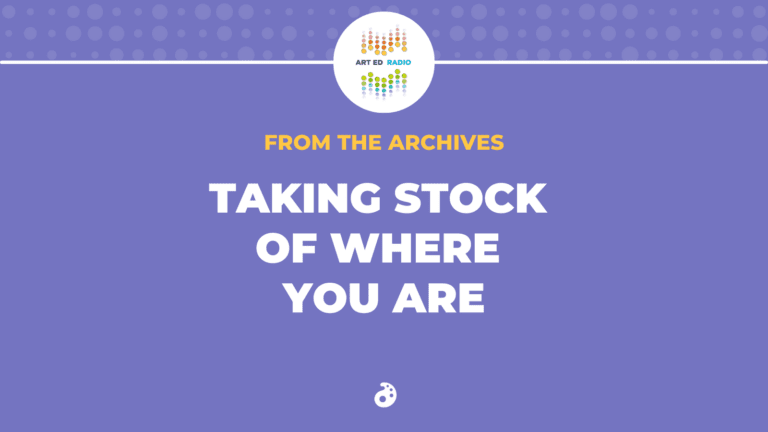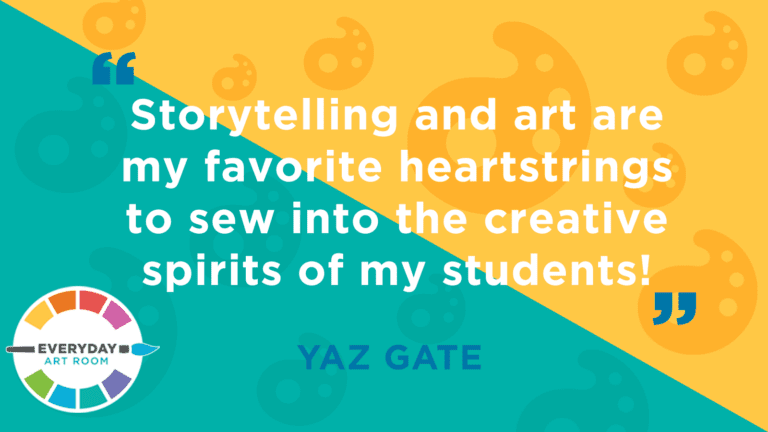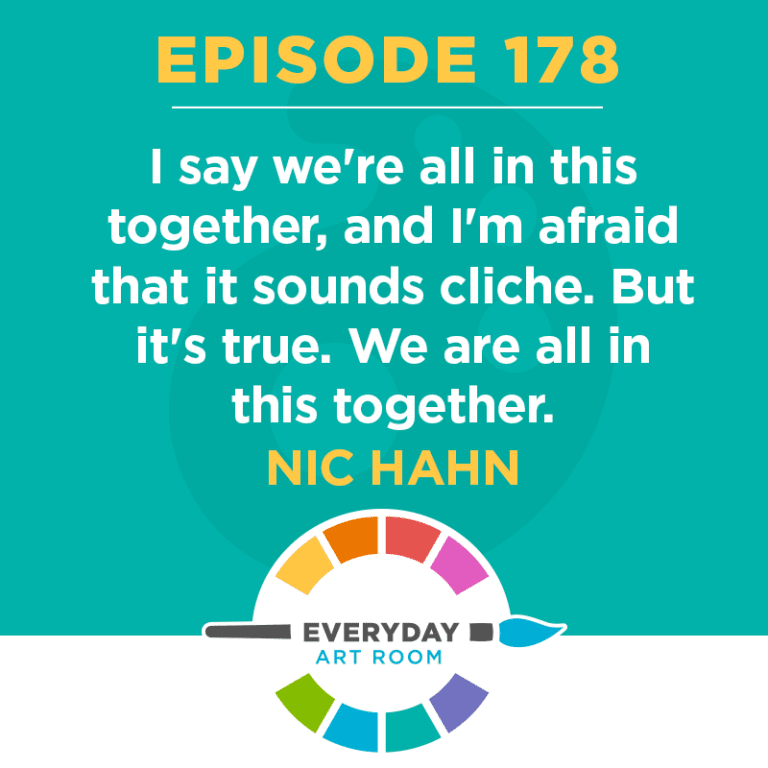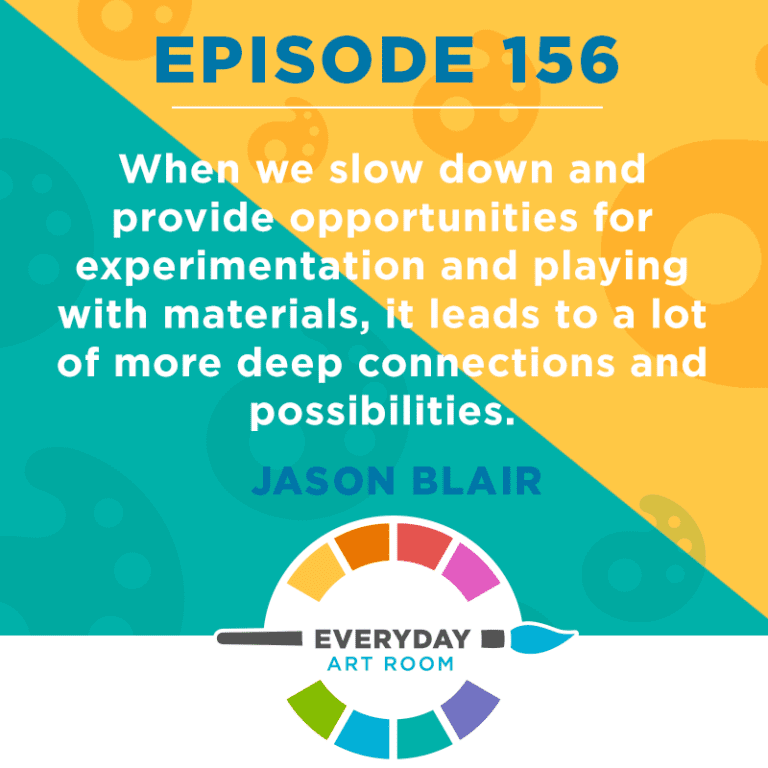We all know that everything in our classrooms and our schools looks different this year, and our art shows are no exception. So how can we solve the art show problem? A virtual art night! In today’s episode, Nic talks to Karen Nall about going online for her art night while still building community with students and families. Full Episode Transcript Below.
Resources and Links
- Follow Karen on Instagram
- 6 Online Platforms to Showcase Student Art
- 10 Ways to Market Your Art Show
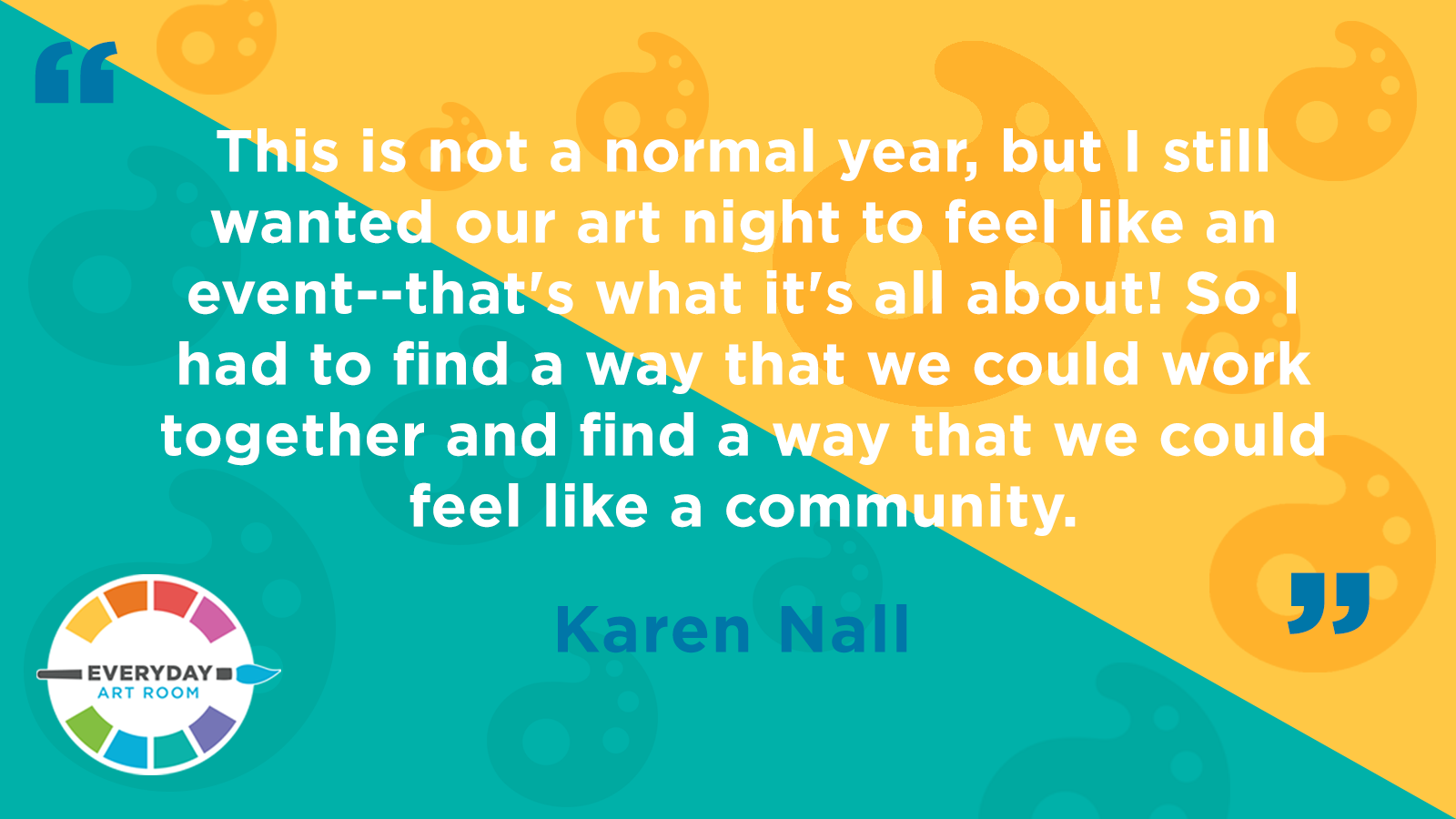
Transcript
Nic: Are you an art teacher who loves to bring the community together to celebrate art? Maybe you like having art shows, or bringing in artists and residents in, and having your community learn from artists and residents. Maybe you like having an art event night. So you have maybe some different activities for families to come in and celebrate art together. Karen Nol is an art teacher who loves to do that. She has many events, but one of them is a clay night. She is going to talk to us about a clay night that she has done in the past and how she has created this clay night even with the restrictions of large gatherings, and the restrictions of use of facilities, how she has created this clay night for the families of her school this year during our pandemic. This is Everyday Art Room, and I’m your host, Nic Hahn.
Thank you so much for joining us today. I’m going to have you just go ahead and introduce yourself, your background and where you’re teaching.
Karen: Hi, my name’s Karen Nol, and I am an elementary art teacher at Lyman Elementary. We are located in Lyman, South Carolina, which is the upstate of South Carolina. It’s a kindergarten through fourth grade school. I have been teaching. This is my ninth year. So I’m reaching the big 10 year mark next year.
Nic: That’s that is a feat actually making that 10 years. You got to feel like, you know what you’re doing now? Huh?
Karen: Yeah. Maybe a thing or two has been learned in the last nine years. Right?
Nic: Exactly. Absolutely. Okay. So you are, you know what I found you, I guess I’ve been introduced to you via Instagram. Can you, what is your Instagram account real quick?
Karen: Yes, it is Nall_star. So it’s N A L L underscore stars.
Nic: Great. Yeah. And you celebrate your students’ artwork on that account, correct?
Karen: I have, I have a more private page that I post more just for the families here at school. I like to use my nall_stars account as more just a teaching resource. Hey, this is for other art teachers. This is what I’m doing. And I also follow other art teachers through that account as well. I use it as kind of my PD account, I guess you could say.
Nic: Interesting. I like that. I like that separation of pages. That’s really, I actually am glad that you mentioned that it’s nice to have an account for your personal, the families of your school and then one to reach out and connect with other teachers. That’s a really interesting idea. I like that. Well, okay. So that’s, that’s how I connected with you. And it was specifically on an arts night that you were coordinating for your family, but were actually families of your school. I want to first talk about what you’ve done in the history of this arts night. Can we go back a couple of years and talk about this arts night that you’ve done with the families of your school?
Karen: Yes. So this was an event that I saw the lady at student teaching. I was student teaching under a woman and she did a similar type event and I fell in love with it and knew it was something that I wanted to have in my future school and for my school community. So I’ve been doing it ever since. I mean, I think I started it my first year teaching. So in a normal year, in a year prior to this year, the event would be hosted at the school at night. It usually runs about two hours and families would come and I had everything set up in the cafeteria with plastic tablecloths on the tables. I would play instrumental music in the background. I served some soft drinks and drinks and hot chocolate. We called it “Clay Cafe”. So I would pre ball about a pound of air dried clay for the families.
And I prep this ahead of time so that when the families got there, they could just basically be given a ball of clay that was wrapped in saran wrap and go ahead and get started. So they pre-registered, and each ball of clay is $5. So about a pound of clay for $5. And the person at the registration table would give them however many balls of clay they paid for on a China plate and they carried it into the cafeteria and they would sit there and it was a free create time. They could make whatever they wanted to on the tables out, printed out some idea sheets, some steps on how to make a pinch pot, how to make a coal pot, some other just general tips that they might want, but I would walk around and I would mingle with the families and give them tips, making sure that they’re scoring and slipping.
So their pieces don’t fall apart when it dries, but it was such an amazing time. Parents would almost get into it more than the kids did, but creations that they would make. And they’re like, “I haven’t worked with clay since I was in elementary school.” And you know, you could work around this full cafeteria of families with, you know, parents and children and nobody’s on their cell phones. Nobody’s got their heads into a device. Their hands are covered in clay and they’re laughing and playing. And it really felt like a step back in time. And it was like an experience that people do not get nowadays where you’re just one-on-one with your kids and really getting to create some special memories with them. And so it was, it was really a truly, it was one of the favorites of the year and people always looked forward to it. We always had a packed house. It was always a great event, so that’s pretty much what it looked like in the past.
Nic: Can I ask some logistics about air-dry clay? Just because I don’t use air-dry clay. So I’m, I’m usually. I have a kiln. And so I’m always using low fire white clay for most of the time. So when you’re using air-dry clay, you, you talked about scoring and slipping. It’s, it’s very similar to like your traditional firing clay. You need to score, slip, use water to connect. Is that correct?
Karen: It is. So the, the teacher Ashley Pearson, who I student taught under, she, when she did this event, she used regular clay. And I mean, she was passing out normal clay that would be fired in a kiln. And then her fans, she had to write the family’s name on a paper and then fire everything and get it back to the families. Well, the school that I started out in did not have a kiln, so I just naturally use air dry clay for this event. And it actually turned out to be kind of a great coming of events because the families took it home on their little Chinet plate. And I sent them with a little note that said, you know, let your clay dry out in the air. It will take a few days. Here’s some tips on how to paint it if you want to. And then I didn’t have to worry about it again after that.
So I, when I started teaching clay, I never knew any difference between air-dry clay and regular clay that you would put in a kiln. It scores and slips the same. It builds the same. I do have a kiln now. So I’ve gotten to work with both, both types. The only difference, the biggest difference that I see is when it dries, I feel like it is a little more brittle because it’s not being fired. It doesn’t flat, rock hard feel that clay that’s been fired in a kiln has, but I’ve never really been able to tell a huge difference in working with both, both types.
Nic: And for the purpose of what you’re doing, that, that tactile just event. It sounds genius to just be able to send it home.
Karen: Yes. Yes. I mean, I don’t know what I would’ve done my first few years if I actually had a kiln, if I would’ve thought, hello, I’m not firing all this stuff and having to get it home to the fam, to the families and I don’t have to worry if they didn’t actually score and slip. Great. And then it blows up in the kiln because they have air pockets. Like you’re not worried about any of that stuff that art teachers freak out over in the classroom. And you can imagine having all these people in the cafeteria and you’re trying to say, make sure there’s no air pockets, make sure, stuff like that, that you make, how you want it to, and you go home and
Nic: That’s like, I’m laughing because when I, when you said, we’ve done this in the past, like I started building rashes on my neck and was like rocking back and forth. Cause I was like, “How could you do this?” Air dry clay, air dry clay people.
Karen: It is the answer to all of your clay event problems. I promise it’s a game changer.
Nic: I love it. I love it. Okay. It’s a beautiful thing. And I love the vision that you give us the explanation of like looking around and seeing just like true family time happening in front of you. What a beautiful, beautiful thing. But now that 2020 – 2021 comes around and you create the same or similar event. Tell us what that looks like. How is it different? How is it the same?
Karen: So I have several school-wide events that involve families and involve this the whole school. And I have really tried this year to creatively find a way to make those events happen in some form or fashion, even with all of the different things that we’re having to endure this year. And I knew that clay cafe had to be one of them. So I was in my head thinking, how can I make this happen virtually? How can I have this at home? And at first I thought about doing just a Zoom with the families. And then I saw this nightmare happening where you had lots of families on Zoom and they were unmuting themselves and talking and interrupting. And it just seemed like a mad chaos, but I just, I was like, okay, there’s got to be another way. And actually in a conversation with my assistant principal, she’s like, just do a Facebook live.
And so I was like, that’s genius. So I did a Facebook Live event that I hosted and I was on our school Facebook page. The families who had liked our school, Facebook page went to that page. And I hosted the event via, Facebook Live. And that way it was a video feed. They could see me and they could still communicate by typing into the chat. And I would answer them on the feed. So I, I didn’t want, it was an easy solution to come up with. Well, I’ll pre ball, the clay anyways. And I wrap it in saran wrap in a normal year. I’m going to make clay kits and send it all home. But I didn’t want just to send the clay home and families just make their clay here, make their clay there, do it next week, or it sit on the counter and it never get, you know, I wanted it to feel like a community.
I wanted it to feel like an event because that’s really what that night is about. So it was important to me to figure out how we could make it an actual event, everybody joining in together at the same time. And so the Facebook Live really was a great solution to comin up with that. So I created clay kits, everybody. It was the same process. You preregistered for your clay. I would spritz the air dry clay, and I do this in a normal year too. I spritz it with a little bit of water before I wrap it. And it’ll stay soft, it’ll say wet for a really long time. But then I would also put that ball of clay in a sandwich Ziploc bag to make sure none of the water might’ve seeped out through the saran wrap.
And then I also created like a pamphlet of papers that had how to get on the Facebook Live general tips. Just again, the how to score and slip, don’t over wet. Your clay will start to break down the particles. If it gets dry, you might need to add a little bit of water. It had some instructions on your pitch pot, how to make a coil pot for them to have on hand, if that was something that they wanted. And then I also included like a Chinet type plate for them to work on. Just thinking some families may need a surface.
Mine are still sitting in my kitchen on the plates. You know, it was just kind of nice to have a place to set them with that as well. And so then all of the contents of the clay kit went into a two gallon and that was something I learned. I didn’t know those existed a two gallon Ziploc bag. They’re ginormous but it fits. So like for each person that registered, if they ordered five balls of clay, they got five plates and one packet of papers and five balls of clay. And I sent those home with the students two days before the event and it was perfect.
So the event came, it was, like I said on Facebook Live and my two children that attend the school here that I teach at. A son who’s in third and a daughter who’s in first grade. And so it was kind of a last minute decision, but my husband was like, Hey, why don’t you have them with you on the video? This is a family thing. You know, in my head, I was like, I’ve got to host this. I need to be focused in, in, in tune with what’s going on, on the live. And he was like, I think it’ll be more family friendly, friendly if you have them with you. So, you can pull up our Facebook page and they’re sitting beside me, they’re working on their clay and my daughter who is an aspiring art teacher herself. She’s like, telling everybody on the Facebook Live, “This is how you make a pinch pot.”
Nic: She’s like, I got this mom, let me, let me take over.
Karen: It really created some fun and some interaction. And so I had, as the families popped on, I asked for them to share with me who their child was. So I knew who was, who was on the live, they would type in, Hey, I’m making a flower pot, Hey, I’m making an Amongus character. And, and we got to chat. And then there were even some teachers and the administrators were on and they were chatting among each other on the Facebook Live comment box on there. My kids would see, Oh, so-and-so from my classroom is on. So then they were talking into the feed. It was so great. It was just a great, it really had a great turnout. It was a great time. I think it was a great medium, like a good meet in the middle for getting some face to face, but not being too overwhelming.
Nic: You mentioned a husband. Did he help with like the, the questions that were coming in? Was someone there to like help read those questions that were coming in on the Facebook Live?
Karen: So originally, I thought like I was going to want somebody there to help, help read those, because I was worried that I would get too caught up in what was going on that I would be able to do that. So I had him there as a backup, but I really didn’t need him. I just set it up on my computer. And I was able to pretty much see everything that, that went on. And so our, our, our live event here at the school and on the virtual clay cafe, it’s a free create. I, I encourage the families to make what they want to and they, they would tell me what they were making, but on the Facebook Live, I also demonstrated some, I was like, Hey guys, if you want to make a pinch pot with me, I’m going to make a pinch pot.
And so we made a pinch pot together, whether they were following along or not was completely up to them, but I just, you know, every now and then I repeated myself a lot. Hi, if you just hopped on and you haven’t heard, make sure you do this, make sure you score and slip and, give them some reminders. My husband was a good asset. He was sitting in the background, like making sure that you could hear me. And it was nice having a third, an extra person there to watch, live, to see that it was connecting. Cause you know, otherwise I would have not really known, is this really coming through the way that it’s supposed to?
Nic: Yes. Yeah. And that, that’s my thought in the back of my head, every time that I think about doing a Facebook Live is like having another person be there to kind of balance and be an administrator during the event.
Karen: Yeah, I do. I do recommend that. I, when I first started, I mean, I’d never done this before, so it was kind of, I have mastered doing it in school. That’s like, I can do that in my sleep and technology. You’ve never done it this way. You’ve, I’ve never hosted a live event like this. So it’s kind of nerve wracking, just crossing your fingers that it goes off the way you want it to. So it was, it was very nice having a, an extra person there. When I, when I first signed on, he was like, honey, you’re showing up as Karen Wallace. Like it was like showing up as my personal account. I was Live-ING on my personal Facebook page. It wasn’t on our school, Facebook page. I was like, Oh, okay. So that, you know, had he not been there it would have not been good.
Nic: I mean, all your kids would have been your friend the next day. Awesome.
Well, really, really good feedback on that. I love that you had so much, and I’m wondering, I’m thinking about it, Facebook lives that I’ve been. Did you have students like posting pictures then of like what they were creating?
Karen: So they weren’t posting pictures on the actual live event. I was encouraging them to take pictures of their work and I’m going to create, I have not yet. I’m going to create a video of all of the students and their work and put it on our school page. You know, one thing that I would do differently next time I had a contest for participation among the classes and the class that had the highest percent of participation was going to get like a popcorn party. I think that if I were, and hopefully we don’t have to do it virtually next year. You live and you learn. I think if I were to do this again, I would love to have a second contest where I encourage students. Hey, every time you take a picture of you and your messy clay hands, or you making something with your clay or you and your finished piece, every picture you send me will go into a drawing.
And if I draw your name, you’ll get a prize. I think that was the biggest thing that I missed being virtual with this event is I love seeing their work and I love seeing what they create and I’m sure they were having a great time with their family, but there’s one thing that you just can’t get on any virtual feed and that’s being able to see everybody else and what everybody else is making. And so trying to beef up and amp up the participation, like the post pictures so that everybody can see, Oh, look, so-and-so made that out of her clay. And he made that out of his clay and things like that. I think I would like to try to gain more participation on that part of it.
Nic: Sure, sure. I know that after the event, you also had a staff event. Can you talk a little bit about that?
Karen: I did. So 30 minutes after our school virtual clay cafe, and I love how you called it a staff after party. That’s really what it felt like. I mean, I’m sure you can relate this year has been really difficult to really build and build on the relationships with your coworkers. I mean, feel like you’re keeping your distance. We have meetings in Zoom and you know, there’s just no interaction. So I really, as well tried to involve our teachers and build the relationships among each other. So I actually hosted this one as a Zoom party. Cause I felt like we could handle that platform a little better. And it was a smaller group of teachers that participated, but I made similar clay kits for them. They bought their clay just like the families did. And we just got on Zoom for a laid back hangout. And we set out with intentions for me to show them how to make pencil holders for their desk.
And I was thinking, we’ll do coil pots and turn them into pencil holders and it’ll be great. And I don’t know that anybody’s actually turned out the pencil holder. We were, I mean, I was in tears multiple times laughing through this process. We were, it was hysterical like the things they were making. And I mean, it was, it was very fun. It was some, it was like therapy for us. And there were teachers on there that don’t get to really hang out and, you know, interact with each other in our building.
But we were on there together and getting to know them and just have conversations that don’t get to happen when you’re at work every day. It was so much fun. And I would love to do it like another time before the end of the year, because we really, we were all rolling, laughing at what some of these teams. I mean, hopefully it doesn’t reflect as a bad teacher on their part. They’re like, “Okay, Ms. Noll, what’s going on here. I should be doing a better job on this,” but we were going with it. We were laughing and we had a good time and hopefully it didn’t reflect how I teach in my classroom because their pencil holders did not turn out like pencil holders.
Nic: I love it. You know what, I don’t think that the clay was the goal there. And you probably met your goal, your, your standard per se. Before we wrap up our conversation is when you’re moving forward. Or if you were talking while you are talking, you’re talking to hundreds of art educators right now who are probably listening to this and thinking, Oh my gosh, this sounds perfect. The first thing we know is go with air-dry clay. That’s genius. I love the suggestion of the Facebook live. What other suggestions do you have for our listeners? If they were going to attempt something like this, this year?
Karen: Recruit some help. I did have, we were blessed in our school. We have assistants that are more than willing to help. And I had somebody to help make the clay kits. In a normal year, I have great coworkers who would help me roll the balls of clay. And we have like a, we have a clay ball rolling party after school. And I get about five teachers in here. It we’re done in an hour. With the COVID this year. I didn’t want to be responsible for hosting anything that required teachers to be in close contact with each other. So I rolled them by myself and that was like 220 balls of clay that I hand-rolled. So just give yourself plenty of time for that. But once the clay was balled up, I could give the materials for the clay kits to somebody else and they were willing to help.
So finding somebody to help you do that would be great. And just showing some excitement. And I think the contest for participation cause the kids were, Hey, who won whose class is in the lead and just drumming up excitement that way. But I mean, you can’t go wrong with something like this. It was, it’s always been a great turnout in person and it was a great turnout here. You know, we had a teacher in our building, she bought eight balls of clay and I was like, you don’t have eight kids in your family. What are you doing with this? And she purchased clay for her friend and her kid, her friend’s kids. And they had a little get together at their house and they all be together. So, you know, we’re all looking for something safe to do right now. And this was a, you know, it’s normally in the week. I host this on a week night during the school year, but I did it on a Friday evening as an option for families to do something with their kids and their comfort of their home. And it was worth every second of work. It was a great, great event.
Nic: That’s amazing. Thank you so much for talking to us about this event.
Karen: You’re welcome.
Nic: There was one more question I had for Karen and I thought we could all benefit from that same question. Karen, what was the profit that your school benefits from as far as this fundraiser go, can, can we talk about the profit as far as this fundraiser goes?
Karen: Yes. I’m so glad you said that because this event actually funds and provides money for all of my clay projects throughout the year. So with $5 per ball of clay, it not only, I, it basically feeds itself what the parents pay for pays for the event, but it provides funds for me to do clay projects with the entire school. And then I usually also profit a couple hundred dollars from it as well. So not only is this event, a great event to have because of the community building and just the special memories and the, just what the families are getting out of it. But as an art teacher, I’m able to fundraise money like this clay night fund raises money for me to have clay projects in my classroom for all the students in the school. And then I usually still have a couple 100 dollars to just keep in our local art account to use as I need for other art materials.
Nic: Perfect. I think that is absolutely the cherry on the top that we needed to hear for putting the efforts in, in such a wonderful event. Yeah.
Karen: I completely forgot about that part. It was actually in my notes. I’m so glad that you had that as a question, because I think that would be an extra motivator for people to do something like this.
Nic: Yes. Yep. And really, we, we want to bring community together, but we also want to make sure that we’re providing what we can for our, our, our classroom and for the events that happen in our school, but in our classroom number one.
Magazine articles and podcasts are opinions of professional education contributors and do not necessarily represent the position of the Art of Education University (AOEU) or its academic offerings. Contributors use terms in the way they are most often talked about in the scope of their educational experiences.
